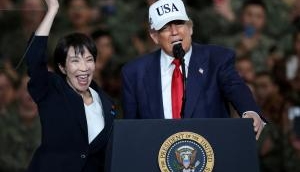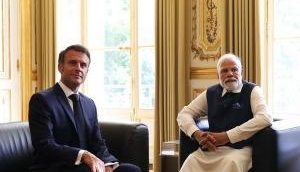
As well as using direct military force and creeping militarisation to advance claimed territories along the Indian border and in places like the South China Sea, Beijing has nefarious and deep-running programmes to extend the influence and reach of the Chinese Communist Party (CCP) across the globe.
Last week, Chairman Xi Jinping attended the seventh Central Symposium on Tibet Work, promoting his policy of subsuming Tibet. Xi is prioritising security in the Tibet Autonomous Region (the name is a misnomer since autonomy is the last thing on Xi's mind), including the need to "solidify border defences and ensure frontier security" along the Line of Actual Control (LAC) with India.
Xi also called for the public to fight against separatism to "form an impregnable fortress in maintaining stability" and to unify Tibetan ethnic groups. His method of doing so is enforcing total loyalty to the CCP and forcing Buddhism to "adapt to socialism and Chinese conditions". In other words, he is subjugating Tibetan identity and religion.
The CCP was definitely alarmed by the boil-over in tensions along the LAC, when Indian and Chinese troops resorted to brutal hand-to-hand fighting in a national battle of wills in mid-June. Twenty Indian soldiers died, while China continues to refuse to acknowledge its number of dead and wounded. Bilateral meetings since then have singularly failed to get the PLA to return to original positions, meaning that China has successfully achieved significant advances in areas like Lake Pangong. Through inattention during COVID-19, India has permanently ceded these swathes to Chinese control with little chance of regaining them.
As well as its subjugation of Tibet, mention must also be made of the dozens of concentration camps in Xinjiang where a significant portion of the Muslim Uighur population is forcibly incarcerated and brainwashed. If China treats its Tibetan and Muslim citizens like this, can one expect it to suddenly alter its nature and treat outsiders with respect?
China's dubious words and promises must be treated with great caution. When core national interests are at stake, nothing is off-limits for China. Its priority is to preserve domestic stability, stimulate economic development, uphold territorial integrity and secure great power status. Furthermore, these core interests hinge upon the CCP's political security - to threaten one is to endanger the other - and this helps explain the extraordinary lengths China goes to in its bullying.
The US has increased the tempo of its denunciations of the CCP for blatant criminal acts, whether intellectual property theft, cyber espionage or influence operations. Indeed, China has enjoyed spectacular intelligence coups against American concerns. A Center for Strategic and International Studies (CSIS) survey listed 137 busted espionage cases against the US alone since 2000, excluding 1,200+ cases of intellectual property litigation brought by US companies.
The CSIS study discerned that 57 per cent of espionage actors were Chinese military or government employees, 36 per cent were private Chinese citizens and 7 per cent were non-Chinese actors. Some 36 per cent of these cases sought to acquire American military technology from 2000-19. Targets have included the F-16 fighter, F-35 fighter, F-22 fighter, F/A-18 fighter, C-17 transport aircraft, Delta IV rocket, various nuclear laboratories, NASA, Patriot PAC-3 missile, supersonic submarine-launched anti-ship missile, Aegis combat system, high-altitude missile interceptors, V-22 Osprey tiltrotor, Black Hawk helicopter, Littoral Combat Ship, satellites, microchip technologies and submersibles. Yet this incomplete list is only those revealed in open sources where the perpetrators were actually caught.
The CCP also has a talent-recruitment programme designed to obtain overseas technology through non-transparent means at best, or illegal methods at worst. China has acknowledged that it attracted nearly 60,000 overseas professionals from 2008-16.
A report from the Australian Strategic Policy Institute (ASPI), entitled Hunting the Phoenix: The Chinese Communist Party's Global Search for Technology and Talent and written by Alex Joske, stated, "These efforts lack transparency; are widely associated with misconduct, intellectual property theft or espionage; contribute to the People's Liberation Army's (PLA) modernisation and facilitate human rights abuses. They form a core part of the CCP's efforts to build its own power by leveraging foreign technology and expertise."
The scale, organisation and level of misconduct set apart China's talent-recruitment scheme. The effort extends much further than the Thousand Talents Plan, for more than 200 different schemes exist. Furthermore, China has some 600 overseas talent-recruitment stations around the world gathering information on scientists and engineers and actively seeking to recruit them.
The US is a primary target, but numerous other nations figure prominently in Chinese efforts to leverage open scientific communities. US investigations into these schemes have only made Chinese efforts more secretive.
The PLA carries out talent recruitment too. The National University of Defence Technology, for instance, has recruited at least four professors from abroad. Similarly, the Chinese Academy of Engineering Physics (which runs the nation's nuclear weapons programme) had recruited 57 foreign experts by 2014, including many from the USA's Los Alamos National Laboratory. As well as direct military force, espionage and talent recruitment subterfuge, China has another arrow in its quiver too.
On September 1, ASPI released a report entitled The Chinese Communist Party's Coercive Diplomacy, authored by Fergus Hanson, Emilia Currey and Tracy Beattie. The report tracks the CCP's use of state-sponsored coercion over the past decade, particularly against Europe, North America, Australia, New Zealand and East Asia, claiming a sharp escalation since 2018.
The report summarised the issue, "The CCP's coercive tactics can include economic measures...and non-economic measures ... These efforts seek to punish undesired behaviour and focus on issues including securing territorial claims, deploying Huawei's 5G technology, suppressing minorities in Xinjiang, blocking the reception of the Dalai Lama and obscuring the handling of the COVID-19 pandemic."
China gains enormous leverage from the fact it is the largest trading partner for two-thirds of countries around the world. This dependency on China as a trading partner enables China to get away with such diplomatic coercion, which is a quite separate issue from "checkbook diplomacy". However, the two do go together, creating a carrot-and-stick approach to advancing Chinese interests and bulldozing anyone in its path.
Yet Hua Chunying, China's Foreign Ministry spokesperson, could declare without any apparent trace of irony in October 2019, "...As a responsible major country, China stands upright with honour. We never strong-arm others, never seek supremacy, never withdraw from commitments, never bully others, and never complain. The word 'coercion' has nothing to do with China."
This ASPI report goes a long way to dispelling such statements as falsehoods, for it documents 152 separate cases where China used coercive diplomacy between 2010 and 2020. Of these cases, 100 targeted foreign governments and the rest individual companies.
There are benefits for siding with China, with the Philippines enjoying not a single case of coercion after President Rodrigo Duterte shifted loyalties to China in 2016. Furthermore, those countries to formally defend China's Xinjiang policies are immune from sanctions.
Of course, exerting pressure has always been the preserve of more powerful nations, and the US and Russia are guilty. However, the Australian authors said, "...The CCP's approach is unique in that it rarely employs traditional methods of coercive diplomacy, which are regulated through the state's official capacity. The CCP is instead arbitrarily imposing measures without officially acknowledging the link between the measures taken and the CCP's interests, which allows for greater flexibility in escalating or de-escalating situations with less accountability and international oversight. This non-traditional type of coercive diplomacy, therefore, requires a very different set of policy tools and responses."
The ASPI report breaks down Chinese diplomatic coercion into categories: arbitrary detention or execution, restrictions on official travel, investment restrictions, trade restrictions, tourism restrictions, popular boycotts, pressure on specific companies, and state-issued threats.
In the 2010-20 period, the researchers found that state-issued threats (34 cases, over half of which were recorded in 2020 alone), trade restrictions (19 cases) and tourism restrictions (17 cases recorded) were the most common methods used by the CCP. The steep rise in state-issued threats in 2020 probably relates to the COVID-19 pandemic, where regular tools such as tourism and foreign student embargoes become moot.
Criticism of China's initial handling of the outbreak, and also of its treatment of Hong Kong, resulted in harsh retorts from Beijing. Even during the pandemic, China was unafraid to use medical supplies to punish other nations.
China's modus operandi uses divide-and-conquer tactics to isolate nations. The ASPI document noted, "Remarkably, countries have so far failed to band together to counter CCP coercion, even when that has been manifestly in their interests. This may be due to a lack of awareness of the widespread use by the CCP of coercive diplomacy, a lack of strategic analysis by foreign ministries of the best way to counter such coercion, or both."
China accounts for more than 20 per cent of global tourism, and 150 million Chinese tourists travelled abroad and spent USD 277 billion in 2018. This is a powerful club for the CCP to wield.
Four countries have felt the full effect of Chinese coercion: Australia, Canada Norway and South Korea. These share a remarkably discernible pattern too. After a trigger, a state-issue threat is typically given, followed by such "incentives" as investment restrictions, trade restrictions, restrictions on official travel and then tourism restrictions or popular boycotts.
Arbitrary detentions or executions might be thrown in too, which is what happened with Canada. After Huawei's chief financial officer Meng Wanzhou was detained in December 2018, China retaliated nine days later by arresting Canadian citizens Michael Kovrig and Michael Spavor on spurious national security laws. They remain in prison.
As for CCP coercion against private companies (including Asics, Calvin Klein, Givenchy, Samsung, Swarovski and Versace), in the end, some 83 per cent of them issued an apology. Virtually none received backing from their respective governments. This translates as an extremely successful victory rate for the CCP, as these profit-driven firms conceded to the power of Chinese consumerism.
The ASPI report was not all doom and gloom, for it listed five suggestions on how countries can counter CCP coercion. It warned, "A coordinated and sustained international effort by foreign governments and companies is needed to counter this coercive diplomacy and uphold global stability."
It specifically mentioned increasing global situational awareness about the widespread use of coercive diplomacy; responding via coordinated pushback through multilateral forums and mini-lateral coalitions; Five Eyes countries considering adopting a collective economic security measure that could draw in other partners; factoring in the heightened risks of doing business with China; and developing economic, foreign and trade protocols in collaboration with the business community to respond to coercive methods applied to business.
China's hypocrisy is becoming more evident too. Beijing feels the need to freely comment on others' internal policies and decisions, whereas when anyone does the same about China, they are accused of meddling in its internal affairs. China continually calls on others to examine their faults and to change their ways, when it utterly fails to ever do so itself.
Additionally, China is investing heavily to manipulate social media audiences, particularly in response to Hong Kong protests and COVID-19. Indeed, the latter has provided China with an environment for the party-state to experiment and refine its propaganda and strategic disinformation. As China leans towards employing Western platforms like Twitter and Facebook (which are banned in China), it can mobilise supporters from the Chinese diaspora. No let-up in this effort is perceived, with propaganda abroad becoming as important as it is at home.
-ANI
Also Read: China puts drones, laser tech on restricted export list amid trade tussle with US







![BJP's Kapil Mishra recreates Shankar Mahadevan’s ‘Breathless’ song to highlight Delhi pollution [WATCH] BJP's Kapil Mishra recreates Shankar Mahadevan’s ‘Breathless’ song to highlight Delhi pollution [WATCH]](https://images.catchnews.com/upload/2022/11/03/kapil-mishra_240884_300x172.png)

![Anupam Kher shares pictures of his toned body on 67th birthday [MUST SEE] Anupam Kher shares pictures of his toned body on 67th birthday [MUST SEE]](https://images.catchnews.com/upload/2022/03/07/Anupam_kher_231145_300x172.jpg)






